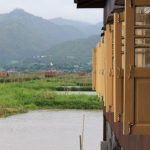Table of Contents
Exploring the World Heritage Sites of Korea
Korea is a country steeped in history and culture, and with its many World Heritage Sites, it’s no wonder why. From the ancient temples and tombs to the royal palaces, these sites are both a testament to the country’s long and rich history, and a reminder of the incredible beauty of the Korean Peninsula.
In this blog post, we’ll explore some of the most incredible World Heritage Sites of Korea, from the ancient city of Gyeongju to the majestic mountains of Gangwon-do.
The Ancient City of Gyeongju
The ancient city of Gyeongju is one of Korea’s most important World Heritage Sites.
Located on the southeastern coast of the Korean Peninsula, Gyeongju served as the capital of the Silla Kingdom from 57 BC to 935 AD. During this period, the city became a center of art and culture, producing some of Korea’s most iconic artifacts, such as the Cheomseongdae observatory, the Anapji pond, and the Bulguksa temple.
Today, Gyeongju is home to some of the most important historical sites in the country, including the impressive Bulguksa temple complex and the ancient burial mounds of the Silla Kingdom.
Gyeongju is also home to the Seokguram Grotto, one of Korea’s most important Buddhist temples. Built in the 8th century, the temple is famous for its stunning granite statues of the Buddha, and for its breathtaking views of the surrounding mountains and valleys.
Visitors to Gyeongju can also explore the ancient tombs of the Silla Royal Family, as well as the historic city of Gyeongju itself, which is still home to some of the oldest buildings in the country.
The Royal Palaces of Seoul
Seoul is home to some of the most impressive royal palaces in Korea. The city is home to five royal palaces: Gyeongbokgung, Changdeokgung, Changgyeonggung, Deoksugung, and Jongmyo.
Each palace is a magnificent complex of buildings, courtyards, and gardens, and each is a testament to the rich history of the Korean monarchy. Visitors to Seoul will find plenty to explore in the royal palaces, from the intricate stone walls of Gyeongbokgung to the beautiful gardens of Changdeokgung.
The palaces are also home to some of the most important historical artifacts in the country, such as the royal thrones and crowns of the Korean kings and queens. Visitors can also explore the many traditional Korean crafts, arts, and foods that are still practiced in the palaces today.
Gangwon-do’s Majestic Mountains
Gangwon-do is a province in the northeast of Korea, and it’s home to some of the country’s most spectacular scenery.
The province is home to the beautiful Taebaeksan National Park, which is home to some of the highest peaks in Korea, and the stunning Seoraksan National Park, which is home to some of the most breathtaking mountain views in the country.
Visitors to Gangwon-do can explore the many hiking trails, campgrounds, and nature reserves throughout the province, and they can also experience the local culture of the region, including the traditional festivals, foods, and crafts.
Gangwon-do is also home to the incredible Jeju Island, a UNESCO World Heritage Site. Jeju Island is a volcanic island located off the southern coast of Korea, and it’s home to some of the most beautiful beaches and landscapes in the country.
Visitors to Jeju Island can explore the lush forests, waterfalls, and volcanic landscapes, as well as the many villages and towns that dot the island.
The Historic Villages of Hahoe and Yangdong
The historic villages of Hahoe and Yangdong are two of the most important traditional villages in Korea. Located in the southeast of the country, the villages are home to some of the oldest and most traditional buildings in the country.
The villages are also home to some of the most important artifacts of the Joseon Dynasty, such as the Confucian schools and academies, which were the main centers of learning during the Joseon period.
Today, visitors to Hahoe and Yangdong can explore the traditional architecture, as well as the stunning views of the rivers and mountains that surround the villages. Visitors can also experience the traditional culture of the villages, including the arts, crafts, and foods that are still practiced in the villages today.
The Historic Fortress City of Suwon
The historic fortress city of Suwon is one of the most important World Heritage Sites in Korea. Located in the south of the country, Suwon was once the capital of the Joseon Dynasty, and it’s home to some of the oldest and most important buildings in the country.
The city is home to the impressive Hwaseong Fortress, which was constructed in the 18th century and is now a popular tourist attraction. Visitors to Suwon can explore the fortress walls and gates, as well as the many cultural sites in the city, such as the Hwaseong Haenggung Palace and the Suwonhanseong Museum.
Visitors can also explore the traditional markets and streets of the city, and experience the traditional culture of Suwon, such as the unique crafts and foods of the region.
The Ancient City of Gyeongju and the Royal Palaces of Seoul
The ancient city of Gyeongju and the Royal Palaces of Seoul are two of the most important World Heritage Sites in Korea. Gyeongju is home to some of the oldest and most spectacular historical sites in the country, such as the Bulguksa temple complex and the ancient burial mounds of the Silla Kingdom.
Meanwhile, the Royal Palaces of Seoul are home to some of the most important artifacts of the Korean monarchy, such as the royal thrones and crowns. Visitors to Gyeongju and Seoul can explore these sites and experience the traditional culture of the region, including the traditional crafts, arts, and foods.
The Historic Villages of Hahoe and Yangdong
The historic villages of Hahoe and Yangdong are two of the most important traditional villages in Korea. Located in the southeast of the country, the villages are home to some of the oldest and most traditional buildings in the country.
The villages are also home to some of the most important artifacts of the Joseon Dynasty, such as the Confucian schools and academies, which were the main centers of learning during the Joseon period. Visitors to Hahoe and Yangdong can explore the traditional architecture, as well as the stunning views of the rivers and mountains that surround the villages.
Visitors can also experience the traditional culture of the villages, including the arts, crafts, and foods that are still practiced in the villages today.
The Historic Fortress City of Suwon
The historic fortress city of Suwon is one of the most important World Heritage Sites in Korea. Located in the south of the country, Suwon was once the capital of the Joseon Dynasty, and it’s home to some of the oldest and most important buildings in the country.
The city is home to the impressive Hwaseong Fortress, which was constructed in the 18th century and is now a popular tourist attraction. Visitors to Suwon can explore the fortress walls and gates, as well as the many cultural sites in the city, such as the Hwaseong Haenggung Palace and the Suwonhanseong Museum.
Visitors can also explore the traditional markets and streets of the city, and experience the traditional culture of Suwon, such as the unique crafts and foods of the region.
The Scenic Islands of Jeju
Jeju Island is a stunning volcanic island located off the southern coast of Korea. The island is home to some of the most spectacular beaches and landscapes in the country, as well as some of the most unique wildlife.
Visitors to Jeju Island can explore the lush forests, waterfalls, and volcanic landscapes, as well as the many villages and towns that dot the island. They can also experience the local culture of the island, including the traditional festivals, foods, and crafts.
The Ancient Tombs of the Silla Kingdom
The tombs of the Silla Kingdom are some of the most important historical sites in Korea. Located in Gyeongju, the tombs are a testament to the long and rich history of the Silla Kingdom, and they are home to some of the most impressive artifacts of the period.
Visitors to Gyeongju can explore the ancient tombs, as well as the burial mounds and artifacts that were found in them. They can also experience the unique culture of the Silla period, including the traditional arts and crafts that were practiced during the period.
The Mountains and Forests of Gangwon-do
Gangwon-do is a province in the northeast of Korea, and it’s home to some of the country’s most spectacular scenery.
The province is home to the beautiful Taebaeksan National Park, which is home to some of the highest peaks in Korea, and the stunning Seoraksan National Park, which is home to some of the most breathtaking mountain views in the country.
Visitors to Gangwon-do can explore the many hiking trails, campgrounds, and nature reserves throughout the province, and they can also experience the local culture of the region, including the traditional festivals, foods, and crafts.
The Crafts and Foods of the Korean Peninsula
Korea is home to some of the most unique and traditional crafts and foods in the world. From the intricate pottery of Gyeongju to the traditional foods of Seoul, visitors to the country can explore the many traditional crafts and foods that are still practiced throughout the Korean Peninsula.
Visitors can also experience the many traditional festivals and celebrations that take place throughout the year, such as the harvest festivals and the traditional Lunar New Year celebrations.
The World Heritage Sites of Korea are a testament to the country’s long and rich history, and they are a reminder of the incredible beauty of the Korean Peninsula.
From the ancient city of Gyeongju to the royal palaces of Seoul, these sites offer visitors the opportunity to explore the culture, history, and beauty of the Korean Peninsula.
So if you’re looking for an unforgettable cultural experience, look no further than the World Heritage Sites of Korea.












